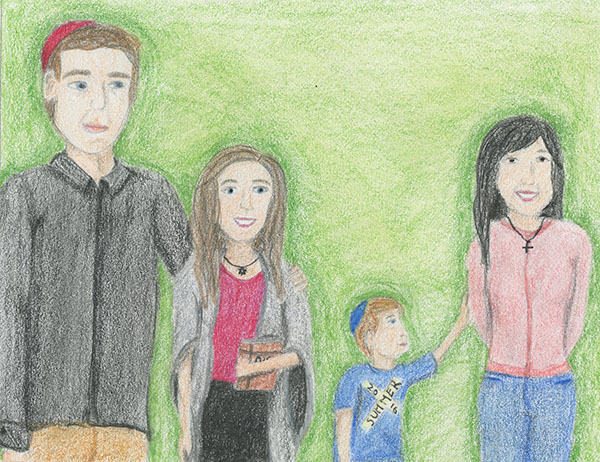South community contemplates dual religion, conversion of faith

Illustration by Ala Jankowski
April 21, 2017
A child’s dream, celebrating two gift-giving holidays, Christmas and Hanukkah. Families who celebrate the holidays and practice religions of two faiths constitute a small percentage of families in the United States, according to the Pew Forum on Religion & Public Life. This is reflected in Glenbrook South, where some students actively practice two religions.
Patty Patt, mother of two Glenbrook South students, Sarah Patt and Emily Patt, was raised in a Catholic household and later married her husband, who was raised Jewish. According to Patty, she and her husband decided to raise their three children as interfaith because they thought it would be the best choice for their family.
“Neither [my husband or I] wanted to convert to the other religion, nor would we ask each other to convert,” Patty said. “In the beginning, we thought we’ll teach [our kids both Judaism and Catholicism] and then they can decide what they want to be when they grow up. As we started this faith journey, […] we realized that the kids considered themselves both Jewish and Catholic.”
Patty says their family soon found the Interfaith Family School offered at Old St. Patrick’s Church in Chicago, where they were able to attend programs and both mass and synagogue specially altered to interfaith families. Junior Gracie Hambourger also goes to Family School and completed a Sunday School program where Judaism and Catholicism were taught.
“In our Sunday school, we weren’t taught the religions blended together or this one is right and this one’s wrong, but rather side by side, comparing stories in Catholicism and Judaism,” Hambourger said.
Family School, Hambourger believes, has drawn her close to a unique community. This was evident on the day of Hambourger’s bat mitzvah, when she said her religion and family seemed to blend together.
“At my bat mitzvah, my priest got sick the day of the ceremony so he texted my rabbi what he wanted to say at the service and she [ended up] reading it off her phone,” Hambourger said. “My mom’s family was there being very supportive and later at the party, we all danced together. The two separate religions didn’t seem to be a thing.”
According to Patty’s daughter Sarah, she has attended Family School programs since elementary school and has embraced both Catholicism and Judaism through religious ceremonies she has taken part in. Sarah claims understanding and practicing both religions has enabled her to be more accepting of other faiths.
“My parents gave me the option of whether or not I wanted to have my first communion, my bat mitzvah, my confirmation […] and each time I chose to do it,” Sarah said. “I wanted to learn more about both faiths [and I ended up gaining] a better cultural understanding of where my family was coming from. It also helped me figure out where I stood and my spiritual and religious beliefs.”
The cultural aspects of faith are what most appealed to History Teacher Daniel Hicks, who converted to Judaism, the religion of his wife, after being raised in both the Church of Christ and as Southern Baptist. According to Hicks, he was so drawn to Judaism that he didn’t consider an interfaith relationship with his wife.
“My wife’s religion has a lot of cultural aspects and dynamics to it that really require a lot of family oriented […] get-togethers, a type of worshipping that’s not really worshipping, but is the retelling of stories that have moral value to them,” Hicks said. “After several years, I found that I really fell in love with the religion.”
According to Hicks, he was skeptical of his Christian upbringing for much of his life, after both sects of Christianity in which he was raised seemed to contradict each other. Hicks explained how this contradiction ultimately helped him decide to abandon religion early on in his life.
“I couldn’t understand how both [the Church of Christ and Southern Baptism] thought they had it right, and then they didn’t agree with one another,” Hicks said. “Yet, they seemed to be studying the same Holy Book. I was questioning religion very early.”
Through her personal journey of faith as well as her family’s interfaith practice, Patty says that she has faced opposition toward her decision that she is able to resist.
“There’s a lot of people that say you can’t have a cafeteria style religion or some people believe that we are trying to make up a new religion,” Patty said. “[To that I respond]: why not take both religions? Why not [have the knowledge] that one religion is not better than the other?”


